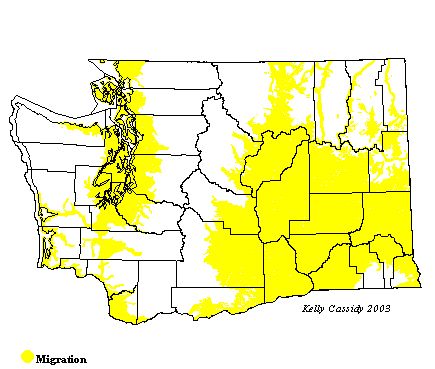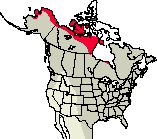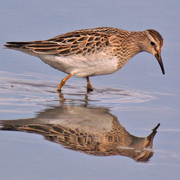Pectoral Sandpiper
General Description
Described as a larger version of a Least Sandpiper, the Pectoral Sandpiper is a medium-sized shorebird with a heavily streaked breast, sharply contrasting clear, white belly, and yellowish legs. The bill droops and is black at the tip, and lighter brown at the base. In flight, the tail shows a dark stripe down the middle, with white on either side. The upper wing has a very narrow stripe. Males are larger than females, and males have inflatable sacs in their breasts, used in courtship.
Habitat
Pectoral Sandpipers breed all across the North American Arctic and across northern Siberia at the dry edges of well-vegetated wetlands. During migration, they can be found in fresh- and saltwater marshes, on mudflats, or drying lakes and wet meadows. They winter in South American grasslands.
Behavior
Pectoral Sandpipers move along steadily with their heads down, picking up prey on the surface and probing lightly into the sand or mud. They usually forage in vegetation, and when they are disturbed, they stand upright with their necks extended, peering over the grass.
Diet
During the breeding season, Pectoral Sandpipers eat flies and fly larvae, spiders, and seeds. During migration, they eat small crustaceans and other aquatic invertebrates, although insects may still be the major food.
Nesting
Pectoral Sandpipers are promiscuous: males mate with multiple females, and females mate with multiple males. Males arrive on the breeding grounds before females and establish territories. When females arrive, the males attract them with a flight display, rhythmically expanding and contracting the air sacs in their breasts. The female builds a nest in a grassy spot on the ground, often on a slightly elevated spot. The nest is usually a well-hidden scrape lined with grass and leaves, sometimes under low shrubs. She provides all the parental care. Incubation lasts for 21 to 23 days, and the four chicks leave the nest and feed themselves soon after hatching. The female stays with the young for about 10 to 20 days. The young start to fly at around 21 days, and are capable flyers by 30 days.
Migration Status
Extreme long-distance migrants, some Pectoral Sandpipers make an 18,000-mile round-trip journey between breeding and wintering grounds. The birds that migrate through Washington most likely breed in Siberia and migrate across the Bering Strait and down the Pacific Coast. They winter in southern South America, Australia, and New Zealand.
Conservation Status
The Canadian Wildlife Service estimates the population of Pectoral Sandpipers at 400,000 birds, with about half that number breeding in North America. Historical reports of enormous numbers along migratory corridors indicate that the population is not what it once was. While hunting may have had an impact in the late 1800s and early 1900s, habitat destruction is currently the most significant threat. There is not a lot of reliable information on population trends of this species, and more data would be helpful. However at this point, the Pectoral Sandpiper is not classified as a species in need of high-priority conservation.
When and Where to Find in Washington
Migrants are much more common in Washington in fall than spring. Fall visitors start showing up in the interior in small numbers in late June. Their numbers increase into July and August, and by mid-August they are common. By late October, numbers start tapering off. They are uncommon by the end of October, and rare through most of November. Coastal birds start arriving in mid-July, but are uncommon through mid-August. From mid-August to October, they are common, then become uncommon again through early November. A few stragglers can sometimes be seen through the end of November. Most of these birds are juvenile.
 Abundance
Abundance
| Ecoregion | Jan | Feb | Mar | Apr | May | Jun | Jul | Aug | Sep | Oct | Nov | Dec |
|---|---|---|---|---|---|---|---|---|---|---|---|---|
| Oceanic | ||||||||||||
| Pacific Northwest Coast | R | R | R | F | F | R | ||||||
| Puget Trough | R | R | R | U | F | U | ||||||
| North Cascades | R | R | R | |||||||||
| West Cascades | ||||||||||||
| East Cascades | ||||||||||||
| Okanogan | U | F | U | |||||||||
| Canadian Rockies | U | F | F | |||||||||
| Blue Mountains | ||||||||||||
| Columbia Plateau | R | R | U | F | U |
Washington Range Map

North American Range Map


Family Members
 Spotted SandpiperActitis macularius
Spotted SandpiperActitis macularius Solitary SandpiperTringa solitaria
Solitary SandpiperTringa solitaria Gray-tailed TattlerTringa brevipes
Gray-tailed TattlerTringa brevipes Wandering TattlerTringa incana
Wandering TattlerTringa incana Greater YellowlegsTringa melanoleuca
Greater YellowlegsTringa melanoleuca WilletTringa semipalmata
WilletTringa semipalmata Lesser YellowlegsTringa flavipes
Lesser YellowlegsTringa flavipes Upland SandpiperBartramia longicauda
Upland SandpiperBartramia longicauda Little CurlewNumenius minutus
Little CurlewNumenius minutus WhimbrelNumenius phaeopus
WhimbrelNumenius phaeopus Bristle-thighed CurlewNumenius tahitiensis
Bristle-thighed CurlewNumenius tahitiensis Long-billed CurlewNumenius americanus
Long-billed CurlewNumenius americanus Hudsonian GodwitLimosa haemastica
Hudsonian GodwitLimosa haemastica Bar-tailed GodwitLimosa lapponica
Bar-tailed GodwitLimosa lapponica Marbled GodwitLimosa fedoa
Marbled GodwitLimosa fedoa Ruddy TurnstoneArenaria interpres
Ruddy TurnstoneArenaria interpres Black TurnstoneArenaria melanocephala
Black TurnstoneArenaria melanocephala SurfbirdAphriza virgata
SurfbirdAphriza virgata Great KnotCalidris tenuirostris
Great KnotCalidris tenuirostris Red KnotCalidris canutus
Red KnotCalidris canutus SanderlingCalidris alba
SanderlingCalidris alba Semipalmated SandpiperCalidris pusilla
Semipalmated SandpiperCalidris pusilla Western SandpiperCalidris mauri
Western SandpiperCalidris mauri Red-necked StintCalidris ruficollis
Red-necked StintCalidris ruficollis Little StintCalidris minuta
Little StintCalidris minuta Temminck's StintCalidris temminckii
Temminck's StintCalidris temminckii Least SandpiperCalidris minutilla
Least SandpiperCalidris minutilla White-rumped SandpiperCalidris fuscicollis
White-rumped SandpiperCalidris fuscicollis Baird's SandpiperCalidris bairdii
Baird's SandpiperCalidris bairdii Pectoral SandpiperCalidris melanotos
Pectoral SandpiperCalidris melanotos Sharp-tailed SandpiperCalidris acuminata
Sharp-tailed SandpiperCalidris acuminata Rock SandpiperCalidris ptilocnemis
Rock SandpiperCalidris ptilocnemis DunlinCalidris alpina
DunlinCalidris alpina Curlew SandpiperCalidris ferruginea
Curlew SandpiperCalidris ferruginea Stilt SandpiperCalidris himantopus
Stilt SandpiperCalidris himantopus Buff-breasted SandpiperTryngites subruficollis
Buff-breasted SandpiperTryngites subruficollis RuffPhilomachus pugnax
RuffPhilomachus pugnax Short-billed DowitcherLimnodromus griseus
Short-billed DowitcherLimnodromus griseus Long-billed DowitcherLimnodromus scolopaceus
Long-billed DowitcherLimnodromus scolopaceus Jack SnipeLymnocryptes minimus
Jack SnipeLymnocryptes minimus Wilson's SnipeGallinago delicata
Wilson's SnipeGallinago delicata Wilson's PhalaropePhalaropus tricolor
Wilson's PhalaropePhalaropus tricolor Red-necked PhalaropePhalaropus lobatus
Red-necked PhalaropePhalaropus lobatus Red PhalaropePhalaropus fulicarius
Red PhalaropePhalaropus fulicarius

